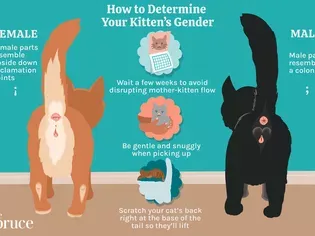How to Tell If a Kitten is a Boy or a Girl
Updated on 05/26/24

Unveiling the Secrets: A Comprehensive Guide to Determining the Gender of Your Kitten
Introduction
Bringing a new furry friend into your life is an exciting journey, and it all begins with choosing the perfect kitten. Whether you're simply curious or have a specific gender preference, being able to tell if a kitten is a boy or a girl is essential. This comprehensive guide will provide you with all the necessary knowledge and techniques to confidently identify the gender of your little feline companion.
Physical Characteristics
1. Genital Area:
The most reliable way to determine the gender of a kitten is by examining its genital area.
* Male: Male kittens have a small, round scrotum located just below the anus. The scrotum may be slightly visible, especially when the kitten is standing or stretching.
* Female: Female kittens have a vertical slit located just below the anus. There is no scrotum present.
2. Distance between Genitals and Anus:
The distance between the genitals and the anus can also provide a clue about the kitten's gender.
* Male: The distance between the scrotum and the anus is typically greater than the distance between the vulva and the anus in females.
* Female: The distance between the vulva and the anus is generally shorter than the distance between the scrotum and the anus in males.
3. Size and Shape:
Male kittens tend to be larger and have a more muscular build than female kittens. Their heads may also be broader and their noses flatter.
4. Tail Position:
When a kitten is relaxed, the position of its tail can indicate its gender.
* Male: Male kittens often hold their tails straight up or slightly curved.
* Female: Female kittens tend to keep their tails lowered or curled to the side.
Behavioral Cues
While physical characteristics provide the most accurate method of determining a kitten's gender, certain behavioral cues can also offer insights.
1. Spraying:
Intact male kittens, once they reach sexual maturity, will start spraying urine to mark their territory. This behavior is not observed in female cats.
2. Roaming:
Intact male kittens are more likely to roam in search of a mate, while female kittens tend to stay closer to home.
3. Aggression:
Unneutered male kittens may exhibit aggressive behavior towards other cats, especially those of the same sex.
Age Considerations
It is important to note that these physical and behavioral characteristics are most evident in kittens that are several weeks old. In very young kittens, the differences may be subtle or not yet fully developed.
Examples
* Example 1: A kitten with a round scrotum and a distance between the scrotum and the anus that is greater than the distance between the vulva and the anus in females is most likely a male kitten.
* Example 2: A kitten with a vertical slit in the genital area and a tail that is lowered or curled to the side is most likely a female kitten.
* Example 3: A kitten that is spraying urine, roaming away from home, and exhibiting aggressive behavior is most likely an intact male kitten.
Conclusion
Determining the gender of a kitten can be a rewarding experience that allows you to make informed decisions about your new furry friend. By carefully observing the physical characteristics and behavioral cues outlined in this comprehensive guide, you can confidently identify your kitten's gender and embark on a joyful companionship filled with love and adventure.
Explore More Pets

Cat Behavior Problems
How to Stop Aggression in Kittens

Long-Haired Cat Breeds
Siberian Cat: Breed Profile, Characteristics, & Care

Cat Behavior Problems
How to Stop Kittens From Scratching and Biting

Long-Haired Cat Breeds
Turkish Angora: Cat Breed Profile, Characteristics & Care

Basic Training
How to Socialize Your Kitten

Short-Haired Cat Breeds
Cute Pictures & Facts About Calico Cats & Kittens

Litter Box Training
Training Your Kitten to Use the Litter Box

Long-Haired Cat Breeds
10 Fun Facts About White Cats
